The Urban Agenda Our Growing Cities Demand
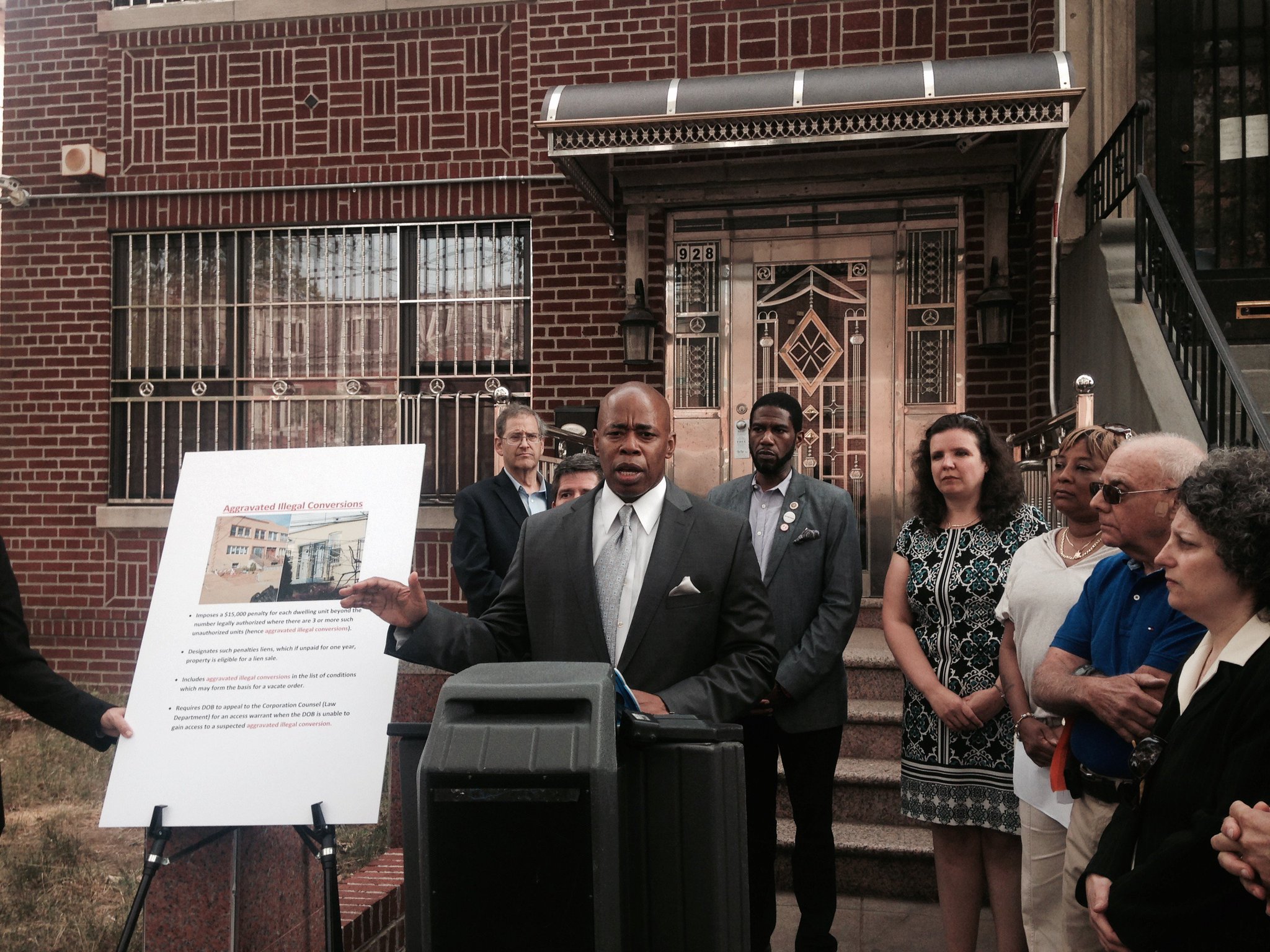
Brooklyn Borough President Eric Adams, the author (photo via @BPEricAdams)
Communities like what we have in Brooklyn represent the future of the United States — vibrant places where people from around the world come to achieve their ambitions.
After many years in which many of our great cities declined in stature, young professionals and couples now want to build their careers and start families in urban America, and older adults want to enjoy their golden years in cities as well. I often say that there are only two kinds of people in the world: those who live in Brooklyn and those who wish they could. The numbers bear that out: our borough now has its highest population in history, representing what would be the fourth-largest city in the country — standing apart from the rest of New York City — with more than 2.6 million residents and growing.
As every teenager experiences a few growing pains, the rapid growth of cities from coast to coast has created some challenges. Many families that have lived in Brooklyn for generations now fear that their income will not support a middle-class life, with rents in some neighborhoods increasing by double digit percentages every year. Our subway platforms have become a crush of elbows and shoulders as commuters struggle to pack themselves into trains during rush hour. And even as crime has declined in New York City, the safest big city in America, there are communities where violence is a persistent threat, where parents are afraid to let their children play outside and the sound of gunshots still punctuates the dark of night.
The Republican National Convention came to a close in Cleveland with nary a word on the fundamental concerns of cities. While the Democratic National Convention in Philadelphia touched on some of these matters through the party platform, we need to ask — better yet, demand — that leaders in both parties go deeper in reflecting on the problems of cities and offering solutions that will allow this country to remain preeminent in an era of continued urbanization. The federal government has the capacity and the duty to step up with this critical assistance, and should do so in the following areas:
Transportation
Every day, commuters living in the greatest city in the world enter subway stations that are more than a century old to crowd into trains that have been in service for decades, some since 1964. Most subway lines still lack countdown clocks. People riding city buses travel at an average rate of 7 MPH (about jogging speed). Our parkways resemble parking lots.
The federal government just adopted a five-year, $305 billion transportation plan known as the FAST Act. Unfortunately, this bill spends nearly 80 percent of its funds on roads with the remainder devoted to mass transit. This allocation fails to account for either the needs of urban commuters who depend on subways, buses, and ferries, or the declining percentage of people throughout the United States who travel by car. A more flexible program that allows individual states to focus their resources on the areas of greatest need would provide New York and other cities with additional resources to build modern mass transit systems.
The federal government must establish a long-term source of revenue for the Highway Trust Fund, which now remains in operation only as a result of gimmicks in the budget that will expire in a few years. Many mass transit projects require several years (or even decades) to complete. A guaranteed investment would eliminate the uncertainty that now exists, which prevents cities and states from developing regional transportation plans to prepare for the needs of future generations.
In addition, commuters should have more flexibility with their transit tax benefits, which allow for pre-tax payments for commuter rail, subway, buses, and parking. There are many people who drive their car to a subway station, then ride the train to work, or alternate on different days, and who should have the option of allocating their payments as desired. Commuters who travel by bicycle also deserve to have the full monthly benefit of the program ($250 rather than $20).
Affordable Housing
The rapid gentrification of New York City has contributed to an affordable housing crisis in which more than half of the families who rent their homes are considered “rent-burdened,” paying more than one-third of their income in rent. There are almost 60,000 people sleeping in homeless shelters each night in New York City — the most since the Great Depression — and many more families living in substandard apartments.
Yet most federal spending on housing primarily benefits high-income homeowners in suburban areas, with the mortgage interest deduction, the property tax deduction, and the partial exclusion of capital gains from the sale of a home. None of these investments are necessarily unwise, but the federal government should consider the two-thirds of New York City residents who rent their homes, the rising number of senior citizens with low to very low incomes, and the increasing number of young people who are renting nationwide. If we are serious about addressing homelessness and the societal challenges that rising housing costs pose to urban America, then Washington’s priorities need to reflect real reform.
It is well past time for the federal government to restore and expand funds to the critical Section 8 rental subsidy. In New York City, the program has not been accepting new applications since 2009, resulting in a scramble for those in need to benefit from the “recycling” of vouchers and forcing many participants to relocate to small apartments that often require a parent and child or unrelated members of a household to share a bedroom. Beyond Section 8 and Section 202 (designated for affordable senior housing), our city’s public housing residents depend on adequate funding to keep their developments maintained to a livable standard. The Rental Assistance Demonstration (RAD) initiative has allowed agencies like NYCHA to leverage their debt and equity for reinvestment in their capital renovations, and it will be up to the next administration to advance this forward.
Going further, we need to jumpstart efforts that would connect the Low-Income Housing Tax Credit to more households through the income averaging reform bill currently stalled in Congress, a measure that would bring needed flexibility to a housing market like New York City’s as well as vital financial resources to keep roofs over the heads of hard-working families without crippling rent burdens.
We also need a Justice Department that actively prosecutes housing discrimination, which has contributed to the crisis. This includes combating rampant tenant harassment by unscrupulous landlords looking to game the system. Some zoning regulations effectively prevent the development of affordable housing that would allow a diverse community to flourish, and the federal government should consider the disparate impact of these restrictions. DOJ should additionally work to prevent discrimination in mortgage lending — in which people of color are offered loans with higher interest rates — that has contributed to many foreclosures.
Gun Violence
The deadly consequences of gun violence continue to threaten families and children in Brooklyn. In neighborhoods such as Brownsville and East New York, homicides and other violent crimes are still disproportionately high. Other cities such as Baltimore and Chicago have, this year, experienced substantial increases in violent crime, which threatens the public safety.
The tide of violence has been swelled by a flood of illegal guns into New York City, which (with New York State), has some of the most restrictive laws in the nation, preventing individuals who present a threat to themselves or other people from owning handguns. Most of the guns used in violent crimes in New York City were purchased in other states and illegally trafficked here, through an “Iron Pipeline” that stretches from Georgia to Virginia and other states that allow gun sales even without identification. Chicago has a similar problem with guns sold in Indiana.
We need common sense reform that only the federal government can provide. Cities are depending on Congress to prohibit gun traffickers from buying large quantities of guns and ammunition to sell in our streets, as well as to institute universal background checks that would prevent criminals from entering the arms trade. Moreover, we need dedicated federal prosecutors who will work with local district attorneys and law enforcement agencies to end the epidemic of gun violence, as well as the ability for the Consumer Product Safety Commission to require that guns include safety features to prevent accidents or unauthorized uses.
According to the most recent Census, more than 80 percent of Americans live in urban areas, a figure that is continuing to climb upward. As the importance of cities grows, so does the need for a proper debate between leaders of the major political parties about the best way to address the challenges facing urban America and the possibilities that exist when the federal government works in cooperation with its municipal partners.
***
Eric L. Adams is Brooklyn Borough President. On Twitter @BPEricAdams.
***
Have an op-ed idea or submission for Gotham Gazette? Email This email address is being protected from spambots. You need JavaScript enabled to view it.
A Better Answer for Clean Energy in New York

A Con Edison Development solar farm
With regard to the recent opinion article by Anne Reynolds of the Alliance for Clean Energy New York:
Our state has already tested the use of long-term power purchase agreements and the result has been high cost for consumers, to the tune of $4.2 billion in above-market rates for Con Edison customers over a 13-year period.
We have a better way to ensure a clean energy future while minimizing the cost to our customers. Utility ownership of large solar and wind farms is the less costly route, and the New York State Energy and Research Development Authority’s own consultants agree with us on this point. We would bid the development and construction of the large-scale renewables to the private sector to get the best price, and then own and operate the facilities at a lower overall cost to customers.
Other states, like Iowa, have achieved high levels of renewable energy without exposing customers to the high costs, risks, and inflexibility of mandatory long-term PPAs. New York should not choose risky, mandatory PPAs when more flexible, lower-cost options with proven records of success are available.
Our state’s utilities have demonstrated an ability to provide safe, reliable, and affordable energy to our customers with our financing and operation of vast, complex energy-delivery systems. We can apply that same expertise to large wind and solar farms by working with private developers to bring benefits to our customers.
***
Matthew Ketschke is vice president, Distributed Resource Integration, for Con Edison Co. of New York, which serves New York City and Westchester County.
The CUNY Tuition Myth
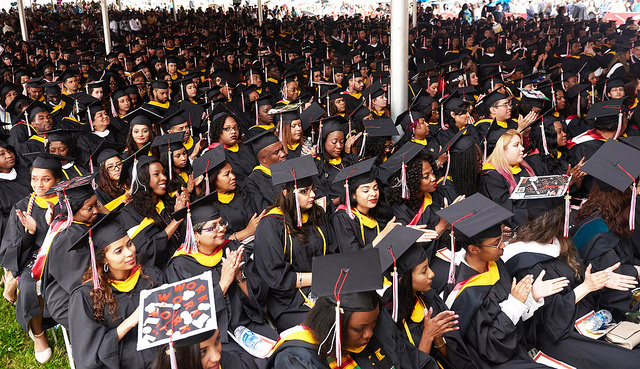
(photo via CUNY on flickr)
Gotham Gazette recently reported that Brooklyn City Council Member Inez Barron, chair of the Council’s higher education committee, introduced a bill aimed at studying the possibility of eliminating tuition in the CUNY system. Barron said, “College should be a right that is part and parcel of a commitment we make to provide free public education in grades K to 12.” Gotham Gazette writes that this was “a ‘commitment’ that was, in fact, extended to college for the majority of CUNY’s history - more than 150 years where the city university system has been an engine of opportunity for city residents, especially those from modest socioeconomic backgrounds.”
While Gotham Gazette does mention that tuition was free for “qualifying students,” many appear to have read the article and missed that point. Unfortunately, there are quite a few people who have accepted the myth that CUNY was free until the 1970s. This was only true for those students who were accepted into the day school. By contrast, during the 1960s, the majority of CUNY students were enrolled in the evening college (SGS) that had a substantial tuition charge.
Indeed, today a larger share of CUNY students have no tuition obligation than did in the so-called free era; the difference being that then it was based on merit while today it is overwhelmingly based on family income.
Today, because of weak skill levels, many entering CUNY students require extensive remediation to reach a minimum level of proficiency. Graduation rates at many of the community colleges are below 20 percent. The overwhelming majority of weakly-prepared students already have no tuition obligation. Barron and other City Council members, and many others, it seems, want to extend this benefit to all CUNY students.
Yet, any free tuition proposal is likely to worsen the situation for those least-prepared for college as the resulting enrollment growth would stretch support resources even more thinly and create more havoc to students’ ability to schedule their classes consistent with their other responsibilities. This is exactly what happened when CUNY began Open Admissions in the 1970s.
As I wrote for Gotham Gazette last year, I believe that all students should have a small tuition obligation. While this would mean the poorest students would have to take out a small debt, they would make much more efficient decisions about their educational choices. It would also close the tuition gap between lower middle-class students and poor students without the costly tuition-free proposal.
However, my two main complaints with the free-tuition proposal are: one, it does not address the issue of making colleges more efficient; and two, it ignores the need to shift to occupational education, focusing on certificate programs, and other short-term occupational programs.
Whether the discussion is around national free tuition or a CUNY proposal that may come from the committee the City Council is considering, even critics neglect to look at ways to improve the four-year college delivery system. Forty years ago, CUNY and most college systems were dominated by a teaching faculty of professors who taught four courses each semester. Now, however, virtually every state four-year college system privileges faculty research so virtually all faculty have teaching loads of no more than three courses per semester. Indeed, based on this research model, new CUNY faculty hires teach only two courses each semester during their six-year probation period. Once CUNY faculty gain tenure they are no longer required to do research but their three-course teaching load continues. Certainly there should be serious discussion of reducing the privileging of research endeavours, and the ability of tenured faculty to maintain low teaching requirements despite no longer doing research.
Faculty are able to reduce their three-course teaching loads by teaching large classes. At Brooklyn College faculty received double credit for teaching 110 students; and the benchmark is lower at other schools. The vast majority of these large sections use multiple-choice exams that are scanned and use textbooks which have quizzes that are submitted and graded electronically. Thus, faculty efforts are virtually the same as for smaller sections and yet they are richly rewarded.
This desire to reduce teaching requirements has also driven some departments to increasingly offer online and so-called hybrid courses where in-class teaching is reduced. At Brooklyn, each semester there are a few faculty members who teach their entire program online so that they are totally absent from campus. Many other courses, including some large sections, are taught as hybrid courses – where students meet once rather than twice each week – so that faculty are on campus only one day each week. When I proposed a resolution that the faculty norm should be a minimum of two days of teaching responsibility each week, not one faculty chair supported it. Thus, colleges increasingly have phantom faculty and administrators have been powerless to stem the tide.
Another way to increase efficiency is to have teaching lines be more consistent with student demand. For years, there has been a decline for many liberal arts majors as student interests have shifted to business and other applied areas. However, tenure and continued elitist notions of college education has limited the reduction of faculty in liberal arts areas. This is most glaring at the CUNY Graduate Center where teaching requirements are half what they are at the four-year colleges.
A whole range of expensive Ph.D. programs reside there in areas where the small number of graduate students has very low prospects of gaining faculty positions. But once more every effort is made to protect these costly programs. Closing down Ph.D. programs at the CUNY Graduate Center, limiting the number of CUNY colleges offering low-demand majors, and consolidating these small departments should be a priority if free tuition is pursued.
A second area of concern is the continued overemphasis on four-year degrees. As mentioned, too many of the weakly-prepared students have an unsuccessful experience in the community colleges that are overwhelmingly geared to the transfer function. And many of those who successfully transfer to four-year colleges flounder and limp to graduation with degrees that do not lead to employment in their fields of study.
For many of these at-risk students, I believe that employment prospects would be greatly improved if they had enrolled in one of the certificate programs CUNY offers. One of the reasons that these students are not encouraged to consider this alternative is that certificate programs are offered through “Continuing Education” and, therefore, participants do not qualify for student aid. Since advocates are unwilling to have these students take out even the small loans necessary to pay for certificate programs, they choose to allow them to fail in the community college system. If the City Council really wants to help poor at-risk students it would expand any tuition proposal to make CUNY certificate programs free. This would not only enable more at-risk students to make effective choices but would undoubtedly shift many similar students away from the for-profit schools which offer much more expensive certificate programs.
During the so-called free era, CUNY students came from a small population cohort that was born during the Great Depression and graduated in the baby-boom era when expanding government services and educational institutions created a large demand for such programs. Today we no longer have expanding government, expanding social services, or expanding teaching positions. Students need more technical and applied skills desired by private industry and public colleges must be transformed to meet these needs.
***
Robert Cherry is Stern Professor at Brooklyn College and CUNY Graduate Center.
***
Have an op-ed idea or submission for Gotham Gazette? Email This email address is being protected from spambots. You need JavaScript enabled to view it.
Power Purchase Agreements Key to Success of Governor’s Clean Energy Goal

Solar panels (photo via ny.gov)
On Thursday, June 12, California set a record for the use of solar power generated by large-scale sources. Over 8,000 megawatts, enough to power six million homes, was flowing through the state’s grid a little after 1 p.m. that day. Yes, it was a very hot day. And they do say that the sun always shines in California. But those aren’t the only reasons for this landmark achievement. The state has made a firm commitment to reducing the use of fossil fuels, both to fight climate change and to control energy costs, and this is a result.
New York is also increasing the presence of solar on our grid, thanks to Gov. Andrew Cuomo’s NY-Sun initiative. Just a few years ago, there was less than 50 megawatts (MW) of solar power in the mix. Today, that number is up significantly, and is expected to grow to over 3,000MW. But it’s going to require the use of long-term contracts, called power purchase agreements (PPAs), if New York’s emerging solar industry is ever going to reach its potential.
And the sun isn’t the only source of clean, renewable power making its way into the homes and lives of New Yorkers. Our use of wind is also growing. In 2004, when the state Public Service Commission (PSC) launched the Renewable Portfolio Standard (RPS) to meet the goal of generating 25% of our power with renewables by 2013, there was 48MW of wind on the grid. Today, we are at 1,754MW, with more than 3,500MW queued up in the regulatory process. So we are heading in the right direction. But the RPS did not meet its target and we are concerned that the state will also miss its next ambitious goal of generating 50% of our electricity with renewable resources by 2030 (50 by 30).
The 50 by 30 goal is a leadership position among states. Cuomo has asked the PSC to develop a plan that gets us there. It is called the Clean Energy Standard (CES), and will be a key part of the Reforming the Energy Vision (REV) currently underway. REV has attracted national and global attention as a new approach to incentivizing renewables and managing the grid. The CES will be officially established by the Commission in early August, the most important energy policy decision in the state this summer.
The benefits of renewable energy are well-known: reducing carbon emissions that cause global climate change; promoting local economic development; diversifying the electricity supply; avoiding the air pollution that contributes to smog and acid rain; providing long-term energy price stability because fuel costs are zero; and keeping energy dollars in-state. The more renewable energy we use, the better off New York is.
As the industry trade group representing large-scale renewable generators, as well as energy efficiency and conservation groups and companies, the Alliance for Clean Energy New York (ACE NY) is seeking a PSC decision requiring utilities to enter into some long-term power purchase agreements in order to make the Clean Energy Standard actually work.
If the goal is to invest in and encourage the growth of non-fossil fuel generators, which are emerging as the future of energy in New York, requiring utilities to sign power purchase agreements with renewable energy generators provides the surest and most reliable path forward. With signed PPAs, wind, solar and other renewable companies can get the financing they need to build the state’s energy future. It also means that for the next several decades, wind and solar generators will be a consistent and steady source of price-stable, cost-effective power.
The state’s own analysis shows that this approach is considerably cheaper than the one used for the last 10 years, which featured a state agency subsidizing renewable energy through the purchase of renewable energy credits (RECs) -- but not buying the energy itself -- known as a REC-only contract. This analysis (Clean Energy Standard White Paper - Cost Study) showed that the 50 by 30 standard can be achieved through mandated PPAs with a negligible 0.03% overall impact to ratepayer bills through 2030. The same analysis projected that an approach using REC-only contracts would have a much greater 1.84% impact on bills over that same period. Power purchase agreements send a much needed long-term market signal to retain and attract renewable energy developers, companies, and investors at the lowest possible cost to New York State taxpayers and ratepayers.
According to the state public service law, and as noted in a recent filing in the CES proceeding by the Natural Resources Defense Council (a member of ACE NY), the PSC “must abide by several statutory requirements in carrying out its regulation of the State’s utilities, including the requirement that it must render decisions that are consistent with the most recent State Energy Plan, and the requirement that it must encourage the State’s utilities to carry out long-range programs to preserve environmental values.” So there should be no legal barriers to including PPAs in the Clean Energy Standard.
The diverse renewable energy industry – including wind and solar power, hydropower, fuel cells, and bioenergy companies – stands ready to invest to help meet our renewable energy and climate change goals. Doing so will position New York as a center of clean energy development. In order to do this effectively, PPAs must be part of the Clean Energy Standard. We don’t know how the state will meet the Governor’s 50 by 30 goal without them.
***
Anne Reynolds is executive director of the Alliance for Clean Energy New York. On Twitter @ACE_newyork.
***
Have an op-ed idea or submission for Gotham Gazette? Email This email address is being protected from spambots. You need JavaScript enabled to view it.
Right to Know Act is Progress We Need Now
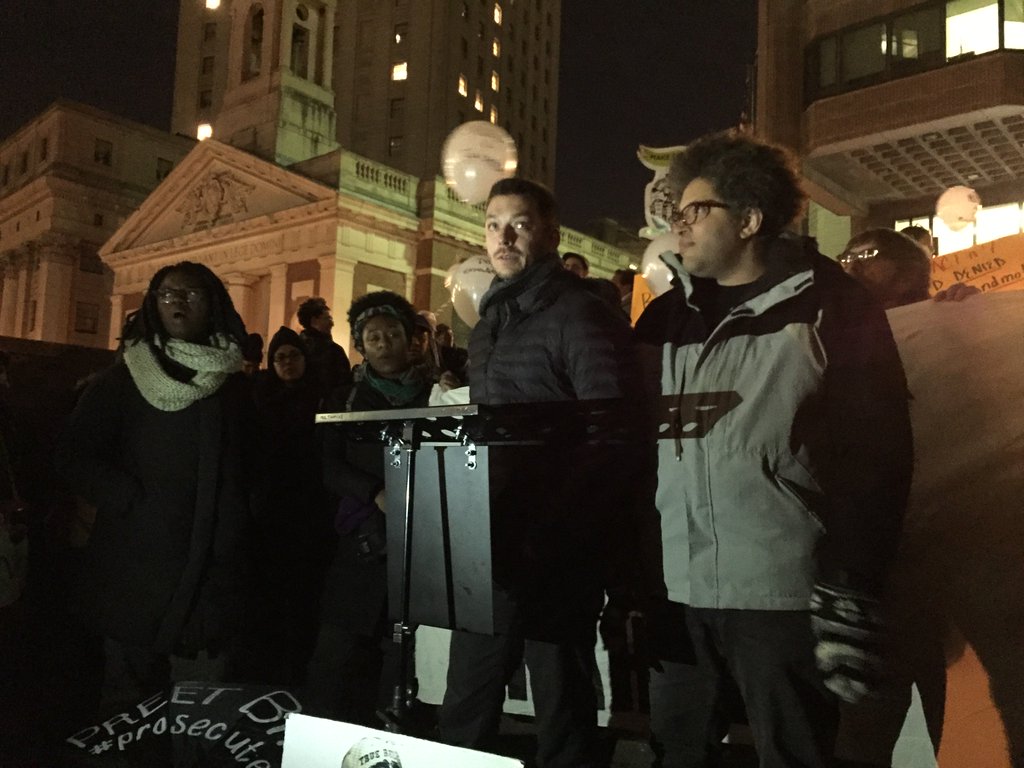
The author, center
I’m lying awake at 4 a.m. wondering if our calls for justice will ever be answered. The evening before I was marching in midtown, protesting the tragic killing of Alton Sterling. It’s been 17 months since the shooting of 12-year-old Tamir Rice and two years since Eric Garner’s death by suffocation at the hands of police. Even with cell phone cameras making this deadly reality no longer something we can ignore, justice remains elusive.
Lying awake, scrolling through Instagram, I noticed a lot of people liking and re- posting a graphic that’s the focal piece of Beyonce’s redesigned website. The redesign is dedicated to the killing of black people by law enforcement in this country over the past two years. It provides a stark picture of our condition. It’s simple enough: a black background with all the names of the murdered typed in white. I looked for my childhood friend’s name. He was killed by Florida law enforcement around the same time as Eric Garner. Not a highly publicized case, so I thought it might have been overlooked. But no, there it was.
I couldn’t stop thinking about how parents feel when their sons and daughters are killed. The horrible grief family members endure. I felt sick. And why shouldn’t I? What if my own father stepped outside his home and didn’t return? Seeing all of this death, having our voices ignored and justice denied time after time, I felt truly demoralized in a way I had never before in my life.
Two years ago, protesting the Garner tragedy, I took part in my first civil disobedience action on the Upper West Side. Soon thereafter, I found myself engaged in community organizing with an organization called Jews for Racial and Economic Justice (JFREJ), searching for peaceful ways to effect positive transformation. I then became JFREJ’s representative to Communities United for Police Reform, a coalition made up of dozens of organizations working toward ending discriminatory policing practices in New York City and beyond.
My main focus and energy has been working to support the passage of The Right to Know Act. This is important legislation that reinforces Fourth Amendment rights on the ground and has the potential to improve relations between the police and communities of color. It’s composed of two bills: the “ID bill” requires an officer to identify him- or her-self when having an interaction with a civilian, and the “consent to search bill” requires officers to inform citizens of their right to withhold consent to be searched where probable cause is absent.
Passing and implementing this legislation would go a long way toward normalizing police-community relations in this city and will allow us to take a step toward the justice that communities of color so richly deserve.
Sadly, the City Council Speaker, Melissa Mark-Viverito, is currently unwilling to bring this groundbreaking legislation to the Council floor for a vote, even though a majority of the Council has signed on to both bills. Instead, she made a backroom deal with Police Commissioner Bill Bratton - the architect of discriminatory Broken Windows policing - and scrapped this bill in exchange for adding a watered-down version to the NYPD patrol guide.
The compromise eliminates any guarantee that individuals will be notified of their right to refuse a search when there is no legal basis for one and discards the requirement for officers to identify themselves in most instances, including when individuals are questioned without reasonable suspicion. This strips the teeth from what is outlined in The Right To Know Act and delivers none of the reforms that President Obama’s Task Force on 21st Century Policing recommended.
The bottom line: we need The Right To Know Act to become law. We know from a long and painful past that administrative prohibitions or protocols do not serve as true agents of change. For more than twenty years chokeholds have been prohibited by the patrol guide, yet this did not stop officers from using that technique resulting in the killing of Anthony Baez in 1994 and, more recently, the killing of Eric Garner in 2014. Effective? I think not. There also happens to be legislation making police chokeholds illegal (except, of course, in life-threatening situations) that is opposed by Commissioner Bratton and has not moved through the City Council.
Would passage of the Right to Know Act be the cure to police brutality? No. More is needed. Education, training, strict enforcement of NYPD rules, and real accountability instead of mere lip service, would also go a long way to eliminating police violence against citizens.
It’s also true we may never be able to eradicate all racial bias, and that some people can’t be educated or trained to be different. However, enacting laws that genuinely require the police to respect black people through proper communication will, in the process, respect everyone’s life, including the lives of police officers. The Right to Know Act would be a positive step on that road to de-escalation and reconciliation.
Let’s demand the Right to Know Act be brought to the City Council floor for a vote. True democracy requires nothing less.
***
Jason Salmon is a community organizer for Jews for Racial and Economic Justice and owns Treehouse Recording Studios in Brooklyn. On Twitter @JasonASalmon.
***
Have an op-ed idea or submission for Gotham Gazette? Email This email address is being protected from spambots. You need JavaScript enabled to view it.
Closed Primaries are Less Inclusive than Soviet Era Politics

State Senator Kaminsky voting
I grew up in a country where most elections were fixed, voting made no difference, and the political process was a dull affair run by a party whose politics were as odious as its leaders. In that country I was able to live and vote without joining the aforementioned party, although I had to withstand poll workers knocking on my door until I exercised my civic right and duty.
This past March, living in a country that prides itself on its democracy, I had to join a party in order to exercise my right to vote. What communists never forced me to do, the world’s oldest democracy did. In fact, I was lucky that I could vote at all. The 27% of registered New York voters not aligned with the Democrats or the Republicans who wished to vote but did not meet the change-of-party deadline six months ahead of the state’s closed primaries had no such luck.
It may go without saying that no one knocked on my door to remind me to exercise my civic duty.
Closed primaries are one of the most damaging aspects of a regulatory scheme that breeds civic apathy. “For members only” is the principle on which these taxpayer-funded primaries operate -- as if they were club elections whose outcomes mattered to members only, and not to all American citizens. But even if you are willing to become a member, obscure deadlines and procedures, which neither party nor the government makes any meaningful effort to explain to the public, will likely put that option out of reach.
And what if one wishes to vote Democratic in the presidential primary, Republican in the congressional primary, and for some other party in the state primary? Not such an unlikely scenario, considering, for instance, the 2095 Bernie Sanders write-ins in the New Hampshire Republican primary and the fact that 7% of voters in the Ohio Republican primary were Democrats. But even short of this type of movement, why should an “unaffiliated” voter not be able to choose a party primary to vote in? Why not allow someone registered with one party to decide that there’s a candidate of another party who really speaks to them?
What if your favorite candidate utters an insult that makes you doubt his or her fitness for public service a week before the primary (not unheard of), and your second choice belongs to a different party? The list of “what ifs” could go on, though all have the same answer: party affiliation in closed primary states can easily become a forced marriage the main benefit of which is best described with the term coined by the disgruntled 2008 Hillary Clinton supporters: PUMA -- Party Unity, My...you get it.
The cost is shutting millions out of elections, perpetuating the political establishment’s grip on our civic life, and voting for our affiliations at the expense of our best interests and convictions. If that is the price we pay for party unity, should we be surprised that party politics is becoming the butt of the joke and an object of scorn to an increasing number of Americans, much as it was to my countrypeople in the last days of the Soviet Union? We would be well-advised to learn from the past mistakes of parties, where civic life was replaced with a party line, lest we suffer similar consequences. As for closed primaries, I say, open them up!
***
Gennady Yusim grew up in the Ukraine. He is currently a Programming & Outreach Librarian at Queens Library.
***
Have an op-ed idea or submission for Gotham Gazette? Email This email address is being protected from spambots. You need JavaScript enabled to view it.
Does the State have the Conviction and Commitment to End Homelessness?
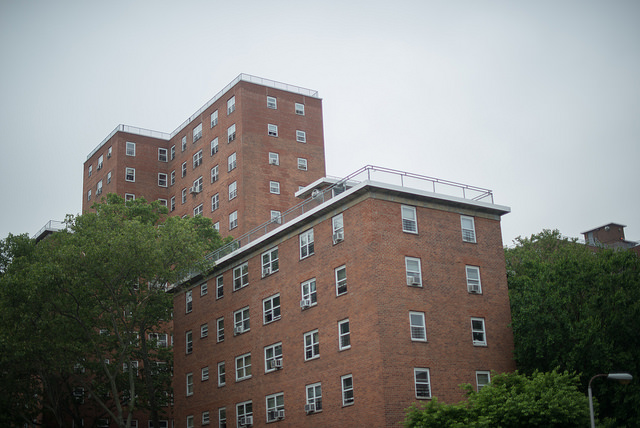
Affordable Housing in East Harlem (Sophie Hecht)
The week of June 26, over 70 San Francisco media outlets came together to report on homelessness in the Bay Area. The collaboration, the San Francisco Homeless Project, produced over 300 local articles, videos, and radio and television segments, as well as similar collaborations in cities across the U.S. and internationally.
Within this much deserved media coverage is the sentiment of a former San Francisco mayor, which may describe what ails our approach to the homelessness crisis here in New York State.
The San Francisco Chronicle’s SF Homeless Problem Looks the Same as It Did 20 Years Ago explains how despite the efforts of the last six San Francisco mayors, homelessness looks similar today to the problem of two decades ago. One of the six mayors, Art Agnos (1988-1992), worked to move San Francisco’s approach to homelessness from overnight shelters to shelters with supportive services. He told the Chronicle:
“We do know what to do, but we haven’t had the conviction or the commitment to make it happen...We could end homelessness as a commonplace occurrence in American cities if we adopted the same kind of commitment we did in addressing World War II: if we treat it like we want to win. But until the public and the politicians who serve them say we are going to win this, we won’t.”
Does New York State lack the conviction and commitment to end homelessness? Are we content to merely manage it, disconnected from its immediacy? While we know what to do - truly affordable permanent housing, including supportive housing, and long-term rental subsidies - are we acting to the extent and at the pace we should so homeless services providers can do their jobs and provide homeless individuals a way home?
Based on recent events in Albany, it is reasonable to conclude that we lack the conviction and commitment to end homelessness in New York.
One piece of evidence is the failure of Albany to adopt a new 421-a tax credit for developers who build truly affordable housing. Yes, the old 421-a program was flawed. Updating it while resolving the issue of prevailing wages for construction jobs is difficult. However, a state committed to ending homelessness would not have passed responsibility from lawmakers to real estate and construction unions to make a deal. A truly committed state government would do all it can to secure a new tax credit so developers don’t scale back new affordable housing projects like Hallet’s Point in Queens.
A second telling event is the delay in new supportive housing, a proven cost-effective tool for ending homelessness. A state government with conviction and commitment would have actualized, with lightning speed, Governor Cuomo’s January 2016 State of the State commitment of 6,000 supportive housing units over the next five years. It would have finalized the details of the 6,000 units before the state budget was finished April 1 instead of resorting to another to-be-determined “memorandum of understanding” (MOU), and then not securing a MOU months later.
A committed state government would not have settled on a short-term measure of 1,200 units over the next year to reactivate the stalled supportive housing pipeline. Short term measures do not address a crisis. They merely manage one.
A desperate need for truly affordable housing, including supportive housing, exists now. According to the Campaign for NY/NY Housing, there’s only one supportive housing unit available for every six eligible applicants. This leaves thousands of applicants languishing in a more costly shelter or on the streets, waiting for a way home. While 1,200 supportive housing units financed for the next year are appreciated, we need funding certainty and programmatic direction from the state for the full 6,000 units. A one year commitment does not allow developers to sufficiently plan, exposing them to financial risk as they take on acquisition and pre-development costs without clear state funding details.
A truly committed state government would expedite the building of truly affordable housing - we can do this now. If we have the conviction to end the homelessness crisis, we won’t wait for another budget. If Albany continues to delay, we should hold lawmakers accountable. Homelessness is worthy of our full effort. We cannot be content to merely manage a crisis that leaves thousands of New Yorkers to suffer.
***
Nicole Bramstedt is the Director of Policy at Urban Pathways, a nonprofit social services and supportive housing organization. On Twitter at @UrbanPathwaysNY.
***
Have an op-ed idea or submission for Gotham Gazette? Email This email address is being protected from spambots. You need JavaScript enabled to view it.
Remembering, and Protecting, Our Essential Rights

Edward H. Gersowitz, the author
For most of us, the month of July means fireworks, barbeques, and a long weekend to kick off the summer. But we should also spend time this month reflecting on the fact that we live in a country founded on the fabric of the Declaration of Independence and the U.S. Constitution. The freedoms we have, and the individual rights we exercise, are a direct result of these key documents.
Several states, including New York, were reluctant to approve the Constitution unless it was amended to protect basic civil rights. The adoption of the Bill of Rights answered those concerns. One of these crucial rights, laid out in the Seventh Amendment, ensures accountability and justice by guaranteeing the right to a jury of one’s peers in civil cases:
“In suits at common law, where the value in controversy shall exceed twenty dollars, the right of trial by jury shall be preserved, and no fact tried by a jury, shall be otherwise reexamined in any court of the United States, than according to the rules of the common law.”
Clearly, the founders of our country knew the importance of the right to bring a claim for civil justice.
Whether it is removing lead from children’s toys and candy; forcing Detroit to finally build safer cars; keeping our air and water clean; protecting against discrimination based on age, sex, race, and sexual orientation; or making sure potentially harmful medicines are properly labeled, the right of victims to a court of law has led to safety improvements that have saved tens of thousands of lives.
But there are those who want to take these rights away.
Corporations and large institutions -- and their lobbyists -- often attempt to bar the courtroom door to those they harm. Forcing consumers into private arbitration proceedings rather than the publicly-owned court system or denying them the right to bring a claim simply because they did not find out about their own injury in time to meet a deadline are tactics they use to deny people justice.
While corporations and institutions claim that lawsuits hurt their bottom line, the reality is that limiting the right to a jury trial can take away a powerful incentive for safety. It allows those who produce dangerous products, provide negligent healthcare, or otherwise harm people through carelessness to escape responsibility for the consequences."
The New York State Trial Lawyers Association works to strengthen America’s civil justice system to ensure that it provides an even playing field for all.
Our role as lawyers is embedded into the foundation of the Constitution. We are honored with the duty and immense responsibility of representing men, women, children, and families who have been wronged. And we have the privilege of bringing about major change and help to individuals when they have nowhere else to turn.
The rights to life, liberty, and the pursuit of happiness are central to our country’s success. And those rights would mean nothing if our right to the courtroom and the ability to exercise our rights without fear and intimidation didn’t exist. The courts protect our independence. And when changes and transformations are introduced to society, the courts are there to ensure balance and equality.
As the fireworks fade after this July 4th, we should all remain thankful for our rights, including the Seventh Amendment, and remember that when it comes to the distribution of those rights and civil liberties, there should be no advantages or disadvantages. The right to a jury trial in civil cases is one of the most important legacies to which we, as Americans, are entitled. We should not squander it.
***
Edward H. Gersowitz took over as President of the New York State Trial Lawyers Association on July 1. He is the first openly LGBT president of a state trial lawyers association in the U.S. and a staunch fighter for civil rights. On Twitter at @NYSTLA.
***
Have an op-ed idea or submission for Gotham Gazette? Email This email address is being protected from spambots. You need JavaScript enabled to view it.
City’s Menstrual Equity Laws Will Help Reduce Period Stigma
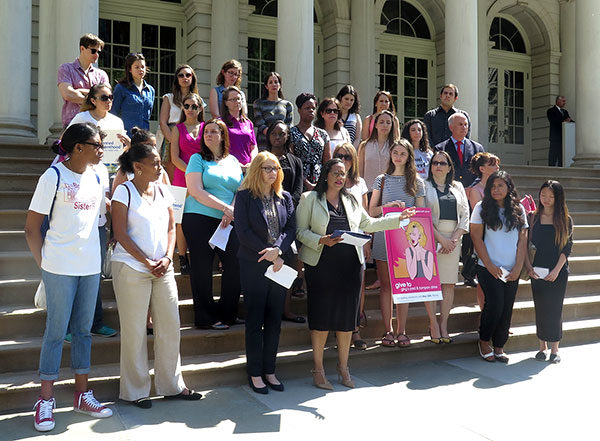
A City Hall rally in support of menstrual equity
My period got me suspended from school. That should not happen to anyone. Yet in New York City and elsewhere, people who have periods—including transgender and gender-nonconforming people—still struggle to access menstrual products and the resources they need. This can hurt their ability to succeed academically, personally, and professionally.
New York just made history when the City Council approved the nation’s first bills of their kind to provide free tampons and pads in all public schools, homeless shelters, domestic violence shelters, and correctional facilities throughout the city. Making menstrual products accessible is a simple matter of dignity and respect.
No one should have to go through what I went through. I started my period on graduation day from 5th grade when I was only 11. There was no way I could tell any of my classmates; the culture of female shame at my school was overwhelming. In middle school, I had very painful menstruation and ended up fainting in class in 7th grade. Of course my best friend told the whole class why, and my school made me leave to go see my pediatrician immediately - not fun. During 9th and 10th grades I missed exams a few times because of my period. My mom wouldn't allow me to see a gynecologist because she was against birth control, and sexuality overall was a problematic subject in our household.
Since I didn’t feel it was possible to talk to my mom and didn’t grow up living with my dad, I had to sneak off campus when I was 16 to speak to a Planned Parenthood provider about using birth control to alleviate the pain from my periods. Planned Parenthood was the only safe space I felt I could talk about my body. The fear I felt even going to a health clinic made me feel silent and alone, and too fearful to ask for a doctor’s note from the provider. I ended up getting suspended from school after the dean found out I left without parental consent.
This was an offense that would be reported and explained to every university I applied to—all because of period and reproductive health stigma!
Regardless of getting suspended and the aftermath, the experience was triumphant overall because it is why I am now interning for Planned Parenthood of New York City and passionate about menstrual equity. It's also why I supported Columbia's student council president on effective ways to push our administration to provide sanitary pads, rather than just tampons for students.
No one should get suspended or have to miss class because they don't have the resources to take care of their own health and body.
I'm thankful that City Council Member Julissa Ferreras-Copeland, Council Speaker Melissa Mark-Viverito, and others are working tirelessly to ensure that individuals in city schools, homeless shelters, domestic violence shelters, and jails can access tampons and pads when they need them. I am grateful that Mayor Bill de Blasio plans to soon sign this legislation into law. Periods—a natural bodily process we cannot control—should not be a financial impossibility or emotional burden for anyone!
Making menstrual products accessible will help normalize conversations about menstruation and sexual health. This will help reduce the shame and embarrassment all people who menstruate, especially youth, have felt about their periods.
Eliminating period stigma has the power to change people’s lives. Everyone who has a period deserves access to the resources to meet their essential needs so that they can stay focused on their futures.
***
Elle Wisnicki is a Health Center Advocate intern in Public Affairs at Planned Parenthood of New York City and has been a campus representative for Planned Parenthood at Columbia University.
***
Have an op-ed idea or submission for Gotham Gazette? Email This email address is being protected from spambots. You need JavaScript enabled to view it.
When is a 'raise' not a raise? The CUNY Faculty Union Deal
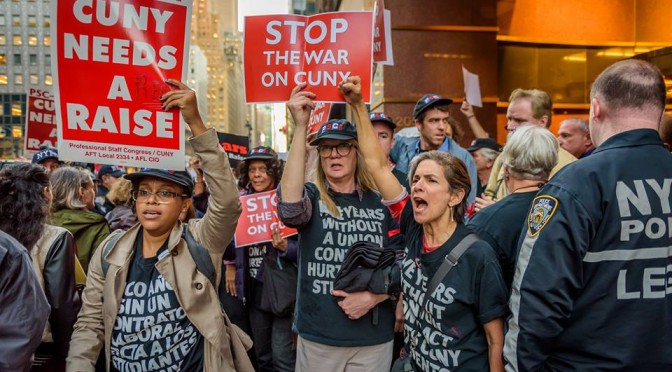
photo: Murphy Institute
When is a “raise” not a raise? When the salary “increase,” adjusted for inflation, is below the base-year salary.
On June 17, after five years of working without a contract and six years without even a nominal raise, the Professional Staff Congress, the City University of New York’s faculty union, announced the main terms of a tentative contract with the CUNY Board of Trustees. Let’s examine how the salary increases in this agreement measure up against erosion from inflation.
In March I wrote a Gotham Gazette op-ed called “CUNY Faculty’s Lost Decade and the Risk Ahead,” pointing out that “In 2015, assistant and associate professors at the top salary step earned 92% in real terms of what they earned in 2006. Full professors at the top step did slightly better, taking home just under 96% of their 2006 salaries.”
These figures derived from my analysis of Bureau of Labor Statistics cost-of-living data and from information on contractual salary increases that PSC-CUNY provided.
The “raises” in the proposed new contract don’t really constitute a raise, even for those of us at the top full professor salary step, who received a special increment in 2009 under the old contract. Most CUNY faculty will again earn in real terms what they took home in 2007. We full professors at the top step will receive slightly less inflation-adjusted salary than we did in 2010 (see table below).
So will I vote to ratify the proposed deal? Yes, but only while holding my nose. I won’t delude myself that I’m getting a real raise, but I would rather be earning almost what I earned in 2010 than 96% of my 2006 salary.
The agreement also contains other extremely important provisions. Adjuncts, for example, the most exploited sector of CUNY’s faculty, will now have the right to multi-year appointments. CUNY management has agreed to negotiate a plan to reduce the onerous teaching load (seven courses per year for full-time faculty at senior colleges) by one course per year. Graduate Assistants who become Adjuncts will receive health insurance. These are all important gains and, in the current context of permanent austerity and bloodletting in public higher education, it would be foolish to vote against them.
The proposed seven-year contract covers a period that has already mostly elapsed. It expires in little more than a year, on November 30, 2017. Wouldn’t it be great if next time CUNY management and the PSC-CUNY could negotiate an actual “new” contract before that date, one which provides raises instead of “raises”? Then, instead of having to spend years lobbying in Albany for a new contract, walking picket lines and testifying before the CUNY Board of Trustees, we could devote ourselves to advancing knowledge and serving the hundreds of thousands of students who attend the largest public urban university in the United States.
CUNY Faculty Salaries and Inflation under Proposed New Contract, 2006-2017
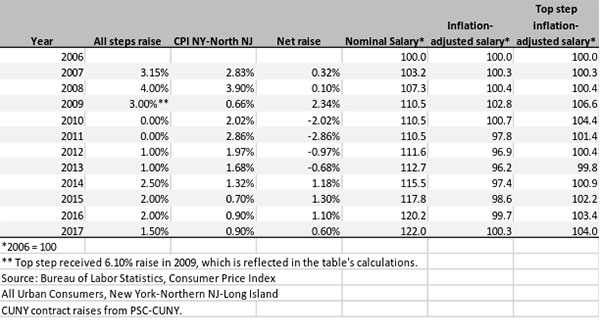
***
NOTES: Three factors understate the salary erosion estimates in the table: (1) Future inflation is unknowable; the Bureau of Labor Statistics estimates 2016 annual inflation at 0.9% for the period through May; I use this figure for 2016 and 2017 even though inflation for key areas (housing, healthcare, food) and overall inflation in 2016-2017 could be higher (because of pending interest rate hikes by the Fed, rising energy prices, financial instability in the European Union and other reasons); (2) The raises in the new contract kick in on April 20 of the respective years; for simplicity I have them covering the whole calendar year; and (3) the lump sum retroactive pay and signing bonus will be taxed in one calendar year.
One assumption in the table overstates the salary erosion estimates. The table does not include the $1000 per full-time employee “signing bonus,” since this will be a different proportion of salary for employees at different ranks and on different salary steps. Taken together, these negative and positive factors are unlikely to alter the salary erosion estimates significantly.
***
Marc Edelman is professor of anthropology at Hunter College and the CUNY Graduate Center.
***
Have an op-ed idea or submission for Gotham Gazette? Email This email address is being protected from spambots. You need JavaScript enabled to view it.




